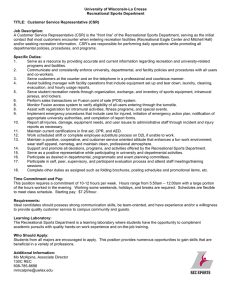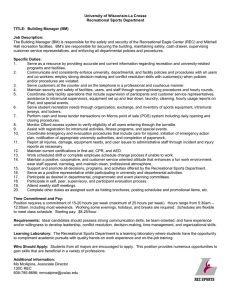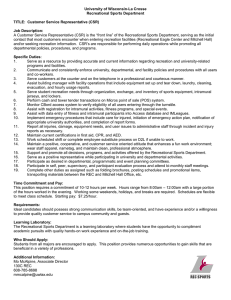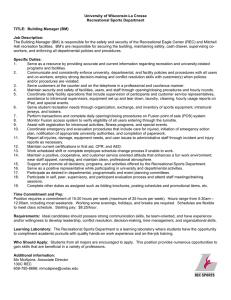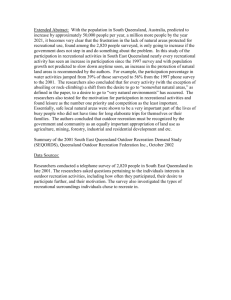Estimating the Economic Value of Recreation ... A Legal and Policy Perspective
advertisement
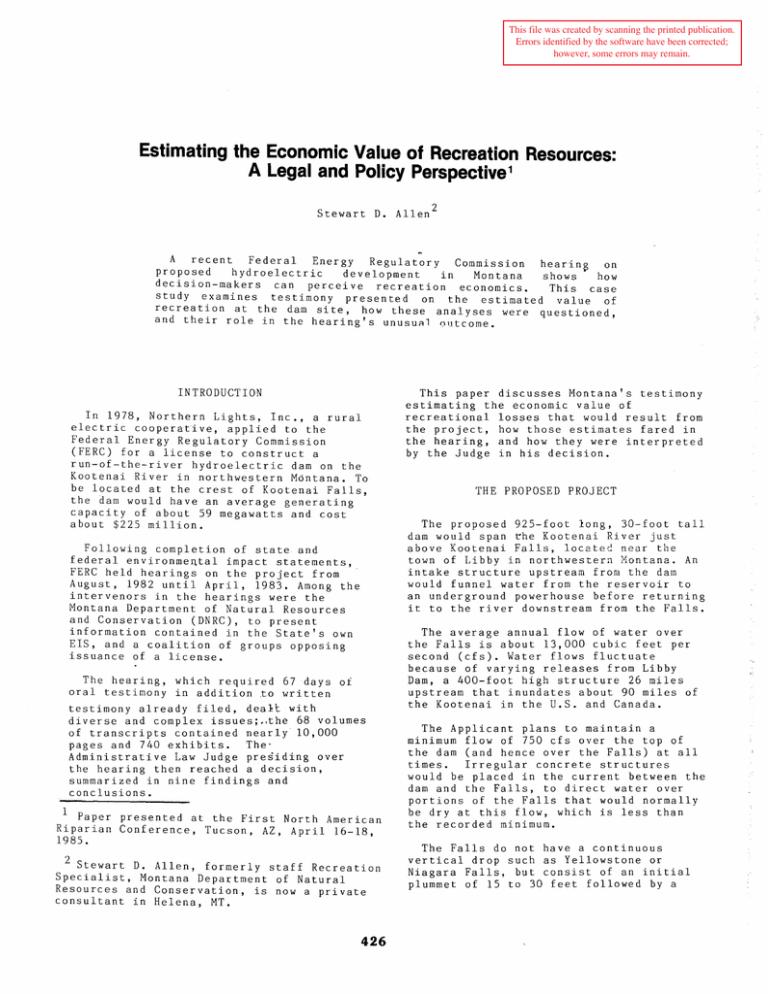
This file was created by scanning the printed publication. Errors identified by the software have been corrected; however, some errors may remain. Estimating the Economic Value of Recreation Resources: A Legal and Policy Perspective 1 Stewart D. Allen 2 Federal Energy Regulatory Commission hearing on A recent proposed hydroelectric development in Montana shows how decision-makers can perceive recreation economics. This case study examines testimony presented on the estimated value of recreation at the darn site, how these analyses were questioned, and their role in the hearing's unusuAl outcome. INTRODUCTION In 1978, Northern Lights, Inc., a rural electric cooperat~ve, applied to the Federal Energy Regulatory Commission (FERC) for a license to construct a run-of-the-river hydroelectric darn on the Kootenai River in northwestern Montana. To be located at the crest of Kootenai Falls, the darn would have an average generating capacity of about 59 megawatts and cost about $225 million. Following completion of state and federal environmental impact statements, FERC held hearings on the project from · August, 1982 until April, 1983. Among the intervenors in the hearinos were the Montana Department of Nat~ral Resources and Conservation (DNRC), to present information contained in the State's own EIS, and a coalition of groups opposing issuance of a license. The hearing, which required 67 days of oral testimony in addition to written testimony already filed, dealt with diverse and complex issues; .. the 68 volumes of transcripts contained nearly 10,000 pages and 740 exhibits. The· Administrative Law Judge presiding over the hearing then reached a decision, summarized in nine findings and conclusions. 1 Paper presented at the First North American Riparian Conference, Tucson, AZ, April 16-18, 1985. 2 Stewart D. Allen, formerly staff Recreation Specialist, Montana Department of Natural Resources and Conservation, is now a private consultant in Helena, MT. 426 This paper discusses Montana's testimony estimating the economic value of recreational losses that would result from the project, how those estimates fared in the hearing, and how they were interpreted by the Judge in his decision. THE PROPOSED PROJECT The proposed 925-foot long, 30-foot tall darn would span ~he Kootenai River just above Kootenai Falls, located near the town of Libby in northwestern Montana. An intake structure upstream from the darn would funnel water from the reservoir to an underground powerhouse before returning it to the river downstream from the Falls. The average annual flow of water over the Falls is about 13,000 cubic feet per second (cfs). Water flows fluctuate because of varying releases from Libby Darn, a 400-foot high structure 26 miles upstream that inundates about 90 miles of the Kootenai in the U.S. and Canada. The Applicant plans to maintain a minimum flow of 750 cfs over the top of the darn (and hence over the Falls) at all times. Irregular concrete structures would be placed in the current between the darn and the Falls, to direct water over portions of the Falls that would normally be dry at this flow, which is less than the recorded minimum. The Falls do not have a continuous vertical drop such as Yellowstone or Niagara Falls, but consist of an initial plummet of 15 to 30 feet followed by a series of smaller falls and cascades through a two-mile long canyon. Access to the Falls area is provided by State Highway 2, which parallels the river for many miles. A dirt road leads to an overlook, but the view is partially obscured and the Falls are several hundred yards away. Rough trails lead down a steep hillside and across a flat area to the crest of the Falls. Other trails lead downstream along the water's edge above the rocky canyon walls. A swinging footbridge crosses the river one-half mile downstream from the Falls, providing access to the undeveloped Forest Service lands on the other shore. Most of the 64,000 or so people who visit the area annually come to view the Falls. Trout fishing is popular in the swift-flowing waters and rapids stretching several miles above the Falls, where the fishery is rated as a Blue Ribbon (highest value) trout stream. Other activities include picnicking, hiking, and boating. Few people raft or kayak the canyon below the Falls, which is Class IV and tougher whitewater. The project is controversial among local residents. A mail survey of Lincoln County residents conducted by DNRC found that s~ightly more people oppsed the dam than favored it, with only 16 percent neutral. STATE TESTIMONY ON RECREATIONAL VALUE The State gained its information on recreational use of the Falls from three surveys: two onsite recreational use surveys; and a mail survey of county residents. This data, combined with many site visits and secondary research, formed the basis for DNRC's description of the existing environment and impact analysis. The State's EIS said that opportunities for viewing the falls, currently the most popular recreational activity at the site, would change substantially if the dam were built. The falls would not be inundated, but the amount of water flowing over them would decrease greatly, lowering the Falls' visual appeal and the s~unds of crashing water present at higher flows. altered because the setting would take on a more developed, utilitarian atmosphere detracting from existing, more-natural conditions. The State believed that recreational opportunities that would be created by the project were already available on the Kootenai River, while opportunities that would be damaged were unique. Northern Lights' proposed mitigation for impacts to recreation, the State testified, would not be effective. Upgrading the primitive existing facilities and improviqg access to the falls would not make up for changing aspects of the falls area that visitors value the most. Proposed visual mitigation--redirecting flow with concrete "rocks," would be ineffective given the small amount of water, the State said. Fewer people would be motivated to walk down to the Falls and many of the site's amenities would,be lost or reduced. The State also conducted an inventory of waterfalls because of debate over whether Kootenai Falls was the last undeveloped waterfall on a major river in Montana. This was found to be the case and moreover, the State concluded tha~ Kootenai Falls was the largest remaining undeveloped waterfall on a major river in the entire Pacific Northwest. This increased the significance of the expected impacts to recreation, because the adverse changes would affect a unique recreational resource. Having described the existing recreational setting, impacts, and the resulting losses in recreational opportunities, the State attempted to place a dollar value on these losses. We believed that this effort required estimating not only direct use values (those associated with on-site recreational use by current visitors) but ~ndirect values (those not dependent ~n current site use). Opportunities for fishing the popular stretch of water above the falls would decrease as the run-of-the-river dam slowed water velocity and created more habitat suitable for non-game fish species. Based on past studies, the State classified indirect values into three categories: option value--individuals' desire to preserve the resource for their own possible future use; bequest value--the desire to preserv~ the resource so it can be experienced by future generations; and existence value--the benefit of just knowing that the resource exists. Other recreational activities available in the area, ranging from whitewater boating to picnicking and hiking, would be The State estimated values using several different methods, each designed to measure a different type of value. These 427 were the travel cost ~pproach and two types of contingent valuation methods: willingness-to-pay (with either a utility fee or entrance fee payment vehicle); and willingness-to-sell, or compensation. So~e respondents were also asked to complete a willingness-to-drive measure, indicating how far out of their way they would drive visit the Falls. the methods attempted to estimate the indirect values to current non-users of Kootenai Falls, an amount that could greatly increase estimated value (Sutherland 1982). The State had hoped to conduct a broad regional survey of non-users, but budget constraints did not permit it. The travel cost method, which estimated demand functions for the site from observed visit rates corresponding to the travel costs from origins at varying distances from the falls, was used to estimate direct use values associated with the falls area. For the contingent valuation methods, visitors to the falls were requested to participate in an iterative bidding game. In one variation, respondents were asked how much they would be willing to pay for an entrance fee (or how much could be added to their monthly utility bills) to preserve the falls. In the other, respondents indicated how much they would have to be paid (via a reduction in monthly utility bills) to compensate for development at the falls. Describing the many intricacies of the methods used and the variations in findings is beyond the scope of this paper, but the State used many techniques to control for strategic, hypothetical, and informational biases. For example, starting bids and jump bids were varied systematically, and respdndents were given one of four levels of information on the project before asked the economic questions. Duffield (1984) contains a more complete discussion of the estimation techniques and Allen (1982) provides more detail on the use of surveys in recreation impact analysis. In summary, the State said that the project would cause irreversible and irretrievable damage to a unique, valuable recreational resource, and that the economic value of these impacts was quantifiable and significant--conservatively estimated at over seven million dollars annually. Respondents also were asked to place a value on the Falls if the dam were built. This figure was subtracted from the existing value amount they had bid, to approximate losses in recreational value. The State believed that compensation was the most appropriate measure of recreational losses accompanying the project, because both direct and indirect values were included. The literature also contains support for using compensation to measure damages to amenity resources (Knetsch 1980) and to measure lost benefits (Dwyer et al. 1976; see also Philip Meyer's paper in this proceedings). The different methods, as expected, yielded different value estimates. The travel cost approach resulted in an estimated annual value of $355,600 for direct use of the falls. The willingness-to-pay an entrance fee estimated annual direct use values as $85,200. The willingness-to-pay on monthly utility bills resulted in an annual value of $1,060,700; this estimate was assumed to include some indirect values .• Finally, the compensation approach, also assumed to include indirect values, estimated annual recreational value of the falls as $7,680,000. The State said that these values were conservative because they assumed minimal increasing use levels at Kootenai Falls and that the value. of the falls would not increase over time. In addition, none of 428 In a later brief, the State said the estimate of recreational value lost should be treated as a risk, given professional debate over the best estimate of the amount. NORTHERN LIGHTS' RECREATION TESTIMONY The project developers testified before FERC that the proposed dam would not have such a dramatic effect on recreation at Kootenai Falls. Their prediction that the project would not damage recreation opportunities at the Falls, and would improve them in some ways, was grounded in their definition of the setting, which differed from the State's. The company's recreation specialist said the Falls served primarily as a rest stop to travelers passing by and as a social gathering area for local residents. He testified that "Kootenai Falls, while scenic, is not in my opinion a place people will visit to gain a high quality natural experience." He said that planned improvements in recreational development at the Falls, such as more picnic tables, better trails and access, and opportunities to tour the powerhouse, would attract more visitors. Existing opportunities would not be affected because there would still be water flowing over the falls. Mitigation, he testified, would include placing concrete structures between the dam and falls, to divert water over the steepest ledges closest to viewers. Northern Lights questioned the survey methodology and findings of the State's two onsite surveys. Their attorneys also disputed the waterfall inventory, claiming that the geographic boundaries were inadequate, that some undeveloped waterfalls were omitted from the inventory, and that Kootenai Falls was not a unique resource. The Applicant did not conduct economic analyses of recreational opportunities, but its lawyers questioned the State's testimony on several grounds. They said that the most serious flaw with this testimony was its mischaracterization of Water Resources Council guidelines for economic valuation. The use of compensation, they stated, was not reliable. Much testimony and cross-examination, in fact, centered on whose interpretation of the Water Resources Council guidelines was correct--even though everyone agreed that they didn't strictly apply because the proposed dam was not a federal project. The Applicant also said that because compensation survey respondents did not know much about the proposed project, they didn't have an adequate basis for giving dollar bids. The large proportion of first-time visitors from out-of-State knew they would not likely be affected so the entire procedure was too hypothetical. Moreover, the Applicant said, the difference between the compensation willingness-to-pay methods, both of attempt to value the same resource, that estimating dollar values was unreliable. large and which showed Northern Lights' ultimate argument, however, was that indirect recreational values could not be described as economic values: "Applicant maintains that it is not possible, in either theory or practice, to convert indirect values into economic values, and any analysis which purports to do so is inherently flawed •.• The indirect use value of a resource cannot be bought and sold in the market place and therefore cannot have an economic value." The few impacts to recreation, the company said, could be mitigated, and planned recreational development would improve recreation at the Falls. The company said the dollar value claimed by the State to represent recreational losses was therefore unfounded. TESTIMONY OF THE FERC STAFF At the hearings, FERC provided its own testimony on the value of recrearion. Its staff economist used a variation of the Unit Day Value method (~n approach the State claimed was "crude at best") to estimate the direct use values of the Falls at $130,000 annually. The proposed dam, he said, would reduce this value to about $50,000 annually. During the intensive cross-examination of witnesses, FERC maintained a low profile, leaving most of the cross-examination to the State, the Applicant, and the groups opposed to the project. These parties were therefore interested in how the FERC staff would view the project in its initial brief. Published in August, 1983, the brief was highly critical of the project, stating, "Staff strongly believes that the issuance of a license to the Applicant in the instant proceeding is not in the public interest and, accordingly, recommends that the Applicant's request for a license be denied •.. The record shows that, on balance, the preservation of the Kootenai Falls area far out-weighs the need for the project." FERC said that the project would have significant and unavoidable impacts on visual and recreational resources, in part because of the greatly reduced flows over the Falls. It did not believe that proposed mitigation would be effective, saying "The net result of Licensee's proposal is the destruction of (one of) the last remaining waterfalls in the Pacific Northwest and its replacement with an outdoor water fountain." The brief argued that both the level and quality of recreational use at the Falls would decrease, and that planned recreational development, the need for which was not shown, would not offset these losses. In summary, Northern Lights believed it had designed an environmentally sound, efficient run-of-the-river dam that would minimize effects to the aesthetic and recreational setting, which was not a unique or particularly valuable resource. 429 those values are to be given ..• However, as discussed hereafter, these indirect values are an important aspect of the decision that no license should issue." THE ADMINISTRATIVE LAW JUDGE'S DECISION After considering the sum of written and verbal testimony, the Judge denied the application for license. His decision was based both on the lack of need for the energy and on the project's impacts--particularly those to recreation and aesthetics at the Falls. His order specified that, "The conflicting interests instrumental in the denial of the application are the changes in the sensual and recreational values that would be caused to the Kootenai Falls by the proposed project ••. " The Judge did not accept Northern Lights' position that the quality of recreation at the Falls would not decrease. Similarly, he accepted the State's view that proposed mitigation would not reduce recreational and visual impacts. He also agreed with the State that the Falls was a unique resource, although he didn't agree entirely with the State's waterfall inventory. In interpreting the decision, it is important to remember that the Judge's standard was whether or not construction of the project would be in the public interest. A central concern was whether the expected impacts would outweigh the benefits of hydroelectric power, and he decided that the current need for the project had not been demonstrated. The Judge based his interpretation of the testimony on indirect economic values on several of the Applicant's criticisms of the State's estimation methods. He agreed that because the majority of visitors were from out-of-State and were seeing the Falls for the first time, their dollar bids should carry little weight. He felt they were not sufficiently informed about the project and its effects to make accurate judgmen.ts about value, and that they were not personally and economically involved enough for their views to be considered. Perhaps more importantly, the Judge questioned the difference between the compensation and willingness-to-pay value estimates: "Anyone is going to be skeptical of methodologies that purport to measure the same subject and get results sometimes as much as twenty times different •.. (the) opinion that these surveys should not be given great weight by decision makers is persuasive." The State's argument that it was appropriate for the two methods to obtain different values was not accepted. In the Judge's Findings and Conclusions, he put it more strongly: " •.. it is not possible to put a dollar value on the principal indirect costs that would result from construction of the Kootenai Falls project." If the need for power had been clearly shown, the Judge may have taken a closer look at the some of testimony (or asked for additional information). An example of this was the Judge's view of the IMPLICATIONS FOR RECREATION ECONOMICS waterfall inventory. The Judge believed that the Falls' indirect values stemmed from their unique nature, but said, "If the need for this potential power were more pressing than it is, it might be important to assess in a detailed manner just how unique the Falls are." Having denied the license, in part on predicted impacts to recreation, the Judge discussed his impressions of the economic testimony. The Judge first decided that the direct use values were relatively small, and would not in themselves block issuance of a license. The issue then became the level of indirect values. He said, "(the State) gave credible evidence as to the direct use value of Kootenai Falls, but there is no credible dollar estimate of the indirect values. This does not mean that those values are unimportant. It only means that a judgment has to be made as to what weight 430 The Judge's perceptions of indirect recreational values should leave recreation economists with mixed feelings. The good news was that the Judge understood and accepted the concept of indirect values. However, his refusal to accept dollar estimates of those values suggests it may be difficult for them to be accepted implicitly in cost-benefit analyses. The case has several implications for recreation economists attempting similar analyses in contested case hearings and other situations. 1. Economic analyses may have value even if the actual estimates are subject to professional debate. Reflecting on the case, one of the State's lawyers believed that the primary value of the economic testimony was to structure the Judge's thinking about recreation impacts, giving him a framework to acknowledge indirect values. Without the actual estimates, the Judge would not have had a range of values to consider. 2. Estimates of recreational value must be firmly grounded in a description of the resource being valued. The State first had to convince the Judge of the recreational importance of the Falls, and then of the project's damaging effects, before he could consider indirect values and dollar estimates. Analyses that produce dollar estimates without first systematically describing the recreational attributes and uses that are being valued may be rejected. If a survey is conducted, for example, one would be wise not to simply ask visitors the minimum number of questions necessary to derive demand curves, or provide contingent valuation estimates. Suppportive data are needed. In the Kootenai Falls hearings, the fact that a recreation planning, management, and behavior specialist was working in conjunction with an economist greatly aided the State's case. Neither was familiar with the methods and approaches of the other, and the resulting exchange of information necessary probably helped both individuals. 3. Good research does not necessarily make good testimony. The many questionnaire variations designed to test for biases probably confused the Judge, and the Applicant tried to capitalize on this. The use of several different methods to estimate different types of economic values also limited the Judge's acceptance. This is not to say that in retrospect the State would have only used one method (such as compensation) to estimate values, but one should be prepared to deal with the complexities involved. 4. Northern Lights' position that values cannot be quantified is a topic that merits further research. More studies that attempt to actually test the validity and reality of individuals' dollar bids for recreational opportunities would help to persuade others that such procedures are not entirely hypothetical. Of course, as more compensation studies are conducted and applied to similar situations, they may gain acceptanc~ ind~rect A survey of non-users of Kootenai Falls, had it found that regional residents would be willing to pay to have a more expensive energy source developed to preserve the Falls, could have anchored the State's estimates of indirect values. Such studies should be seriously considered, especially because the values involved could be significant. 431 5. Some of the problems encountered are perhaps inherent in recreation economics testimony. A State lawyer pointed out that if the Judge had accepted the indirect dollar estimates for recreation losses, a case could have been made that the indirect values of the hydroelectric energy should also be considered. Perhaps people place a value on knowing that an energy source is located closer to their homes, or that the source is cleaner than a coal-fired power plant, or that future generations will be able to depend on renewable energy. Needeless to say, this really throws the economic analyses for such projects wide ~pen, creating a potentially uncomfortable situation for decision makers. Also, a full analysis would ideally consider the indirect values and losses present at alternative energy sites--a monumental task for the typical EIS budget. CONCLUSIONS Hydroelectric projects may yield very large, credible economic value in terms of the energy produced.! If recreation (or other resources) would be adversely affected, the value of impacts to direct use may not be sufficient to outweigh the power benefits unless the affected resource is both unique and extremely popular. The value of indirect benefits may therefore be crucial to future development decisions, and is worthy of attention by lawyers, economists, and recreation professionals alike. Finally, the tale's not over. Northern Lights appealed the Judge's decision to the full Commission claiming, in part, that the State had failed to convince the Judge that indirect values could be quantified. FERC's decision is due this summer. LITERATURE CITED Allen, S.D. 1982. Evaluating the impacts of resource development on recreation: A case study. Proceedings of the Intermountain Leisure Symposium, Brigham Young University, November, 198~. Duffield, J. 1984. Travel cost and contingenl valuation: A comparative analysis. Advances in Applied Micro-Economics 3: 37 - 50. Research for Parks and Recreation in the 80s. University of Victoria, Canada. Dwyer, J.F., Kelly, J.R., and Bowes, M.D. 1976. Improved procedures for valuation of the contribution of recreation to national economic development. Research Report 128, University of Illinois, Urbana-Champaign. Knetsch, J.L. 1980. Disparities between alternative measures of economic values. Proceedings, Applied 432 Sutherland, R.J. 1982. Recreation and preservation valuation estimates for Flathead River and Lake system. Kalispell, MT: Flathead River Basin Commission.




